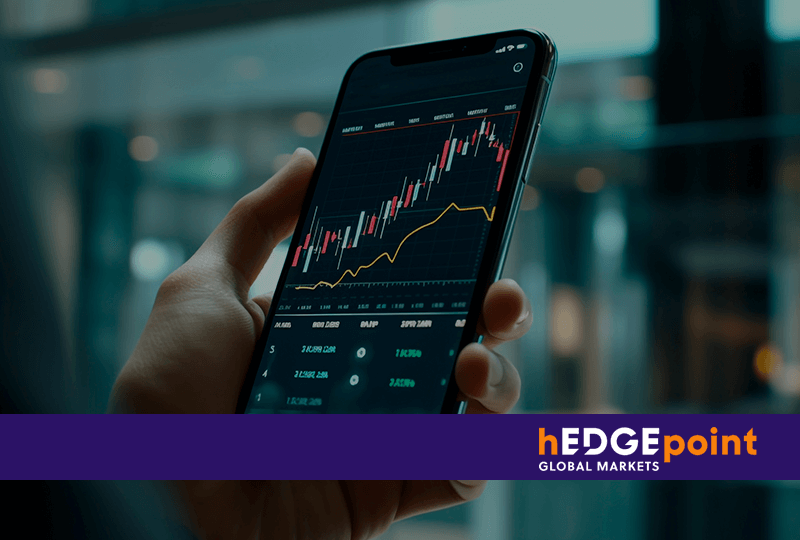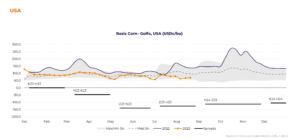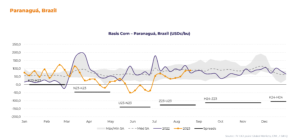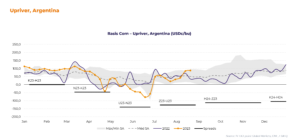
In the commodities market, the term “basis” refers to the difference between the physical price practiced in a specific local region and the price in the f

In the commodities market, the term “basis” refers to the difference between the physical price practiced in a specific local region and the price in the futures market for the same commodity. The future price is related to the asset’s price on the reference stock exchange, always based on the nearest maturity contract.
To help you understand, let’s use corn as an example. Suppose the physical price in the region of Sorriso, in the Brazilian state of Mato Grosso, is around R$ 75.00 per sack.
The quotation for the next contract for the same corn on B3, the acronym for the Brazilian stock exchange, is R$ 95.00. Here, the basis value will be negative R$ 20.00. When evaluating this value within a historical analysis, it’s possible to compare with averages from other years and identify whether the current market situation favors buying or selling.
In this text, we explain how the basis calculation is performed, which factors influence its price, and we present the two main strategies involving it.
Keep reading and find out more!
In local markets, the price of a commodity is adjusted according to the quotations practiced on stock exchanges and variables such as freight, handling, storage, quality, exchange rates, and supply and demand factors affecting that specific area.
The basis is calculated by subtracting the spot price of the commodity in the physical market of a specific local region from the price of the same product in the futures market, which can result in a positive or negative value. When it’s positive, it means that the product in the physical market has a higher spot value than in the futures market. In this case, it’s often referred to as a premium or a markup. If it’s negative, it’s called a discount or markdown.
If the trading is being done through futures contracts on the Chicago Board of Trade (CBOT), for example, the basis calculation should take into account the conversion of sacks into bushels (a unit of measurement used for trading grains on international exchanges).
Basis can be influenced by four factors:
The price curve of futures contracts reflects the balance between supply and demand. It’s a graphical representation showing the quotations of futures contracts for a commodity over different maturities.
This curve is an important tool for businesses involved in the global commodities chain, as it provides information about the market’s expectations regarding future commodity prices.
For most agricultural commodities, there’s a seasonality in the volume produced. In the Southern Hemisphere, for example, periods of higher supply occur in the first half of the year. Therefore, we observe a weakening of the basis in countries like Brazil, as the future market price grows more than the spot price.
In the second half of the year, a more significant supply is identified in the Northern Hemisphere, a period when the basis in South America strengthens due to a smaller locally offered volume. Thus, the spot price grows more than the future price.
In Brazilian regions with higher grain storage capacity, there’s the possibility of storing the product for sale when the local price is more attractive.
When there’s no storage capacity, producers are obliged to trade their product shortly after harvest. The excess supply during this period results in price pressure and a more pronounced seasonal curve of basis.
In the graphs below, you can see the variation of corn basis in Argentina, Brazil, and the United States, observing the difference in values according to the hemispheres.



It constitutes an influencing factor in the commodities basis for those that have their price referenced in foreign exchanges, such as soybeans and corn. In these cases, a strengthening of the exchange rate could result in a weakening of the basis in the Brazilian local markets. Conversely, a stronger local currency exchange rate tends to strengthen the basis in local markets.
The logistical costs associated with transporting goods from the field to the export port are one of the main influencing factors in the basis. Port costs and other necessary fees for shipping the production must also be included in the calculation. The price attributed to the shipped product available for export is known as the Free on Board (FOB) price.
The basis can be applied strategically in two ways to benefit traders:
The basis is a rather complex subject influenced by various factors, both global and regional. Understanding this concept makes a significant difference in business.
hEDGEpoint deeply understands the commodities sector and the aspects that affect its dynamics. With market intelligence, data analysis, and the multidisciplinary knowledge of our team, we offer hedging tools to manage risks in this market.
Speak to a hEDGEpoint professional and learn how we can assist you.

Rua Funchal, 418, 18º andar - Vila Olímpia São Paulo, SP, Brasil
Contato
(00) 99999-8888 example@mail.com
Section
Home
O que Fazemos
Mercado
Quem Somos
HUB
Blog
Esta página foi preparada pela Hedgepoint Schweiz AG e suas afiliadas (“Hedgepoint”) exclusivamente para fins informativos e instrutivos, sem o objetivo de estabelecer obrigações ou compromissos com terceiros, nem de promover uma oferta ou solicitação de oferta de venda ou compra de quaisquer valores mobiliários, commodity interests ou produtos de investimento.
A Hedgepoint e suas associadas renunciam expressamente a qualquer uso das informações contidas neste documento que direta ou indiretamente resulte em danos ou prejuízos de qualquer natureza. As informações são obtidas de fontes que acreditamos serem confiáveis, mas não garantimos a atualidade ou precisão dessas informações.
O trading de commodity interests, como futuros, opções e swaps, envolve um risco substancial de perda e pode não ser adequado para todos os investidores. Você deve considerar cuidadosamente se esse tipo de negociação é adequado para você, levando em conta sua situação financeira. O desempenho passado não é necessariamente indicativo de resultados futuros. Os clientes devem confiar em seu próprio julgamento independente e/ou consultores antes de realizar qualquer transação.
A Hedgepoint não fornece consultoria jurídica, tributária ou contábil, sendo de sua responsabilidade buscar essas orientações separadamente.
A Hedgepoint Schweiz AG está organizada, constituída e existente sob as leis da Suíça, é afiliada à ARIF, a Associação Romande des Intermédiaires Financiers, que é uma Organização de Autorregulação autorizada pela FINMA. A Hedgepoint Commodities LLC está organizada, constituída e existente sob as leis dos Estados Unidos, sendo autorizada e regulada pela Commodity Futures Trading Commission (CFTC) e é membro da National Futures Association (NFA), atuando como Introducing Broker e Commodity Trading Advisor. A Hedgepoint Global Markets Limited é regulada pela Dubai Financial Services Authority. O conteúdo é direcionado a Clientes Profissionais e não a Clientes de Varejo. A Hedgepoint Global Markets PTE. Ltd está organizada, constituída e existente sob as leis de Singapura, isenta de obter uma licença de serviços financeiros conforme o Segundo Anexo do Securities and Futures (Licensing and Conduct of Business) Act, pela Monetary Authority of Singapore (MAS). A Hedgepoint Global Markets DTVM Ltda. é autorizada e regulada no Brasil pelo Banco Central do Brasil (BCB) e pela Comissão de Valores Mobiliários (CVM). A Hedgepoint Serviços Ltda. está organizada, constituída e existente sob as leis do Brasil. A Hedgepoint Global Markets S.A. está organizada, constituída e existente sob as leis do Uruguai.
Em caso de dúvidas não resolvidas no primeiro contato com o atendimento ao cliente (client.services@hedgepointglobal.com), entre em contato com o canal de ouvidoria interna (ombudsman@hedgepointglobal.com – global ou ouvidoria@hedgepointglobal.com – apenas Brasil) ou ligue para 0800-8788408 (apenas Brasil).
Integridade, ética e transparência são valores que guiam nossa cultura. Para fortalecer ainda mais nossas práticas, a Hedgepoint possui um canal de denúncias para colaboradores e terceiros via e-mail ethicline@hedgepointglobal.com ou pelo formulário Ethic Line – Hedgepoint Global Markets.
Nota de segurança: Todos os contatos com clientes e parceiros são realizados exclusivamente por meio do nosso domínio @hedgepointglobal.com. Não aceite informações, boletos, extratos ou solicitações de outros domínios e preste atenção especial a variações em letras ou grafias, pois podem indicar uma situação fraudulenta.
“Hedgepoint” e o logotipo “Hedgepoint” são marcas de uso exclusivo da Hedgepoint e/ou de suas afiliadas. O uso ou reprodução é proibido, a menos que expressamente autorizado pela HedgePoint.
Além disso, o uso de outras marcas neste documento foi autorizado apenas para fins de identificação. Isso, portanto, não implica quaisquer direitos da HedgePoint sobre essas marcas ou implica endosso, associação ou aprovação pelos proprietários dessas marcas com a Hedgepoint ou suas afiliadas.
aA Hedgepoint Global Markets é correspondente cambial do Ebury Banco de Câmbio, de acordo com a resolução CMN Nº 4.935, DE 29 DE JULHO DE 2021, Artigo 14 do Banco Central do Brasil (BACEN).
Para mais informações sobre nosso parceiro, serviços disponíveis, atendimento e ouvidoria, acesse o link a seguir: https://br.ebury.com/